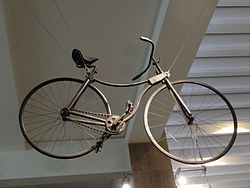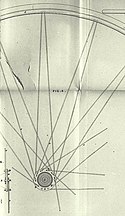Wheels and wheeling; an indispensable handbook for cyclists, with over two hundred illustrations (1892) (14592565399)
Identifier: wheelswheelingin00port (find matches)
Title: Wheels and wheeling; an indispensable handbook for cyclists, with over two hundred illustrations
Year: 1892 (1890s)
Authors: Porter, Luther Henry
Subjects: Cycling Bicycles
Publisher: Boston, Wheelman Company
Contributing Library: The Library of Congress
Digitizing Sponsor: The Library of Congress
View Book Page: Book Viewer
About This Book: Catalog Entry
View All Images: All Images From Book
Click here to view book online to see this illustration in context in a browseable online version of this book.
Text Appearing Before Image:
s the case with tires that are stretched and ce-mented on—is four inches longer than the circumfer-ence of the felloe. This gives us about twenty-fiveper cent, more rubber than they have, forming a verydecided elastic cushion. The rubber will not as easilycut, and any cut made will be pressed together, notdistended under tension. The tire may be pushed aside sufficiently to admitof the putting in of a spoke. It is made of the very bestsoft rubber, i;-inch diameter, and the chief object ofhaving a hole through it is to admit of its being fixed,without stretching in the rim, by means of wire, in-stead of the unsatisfactory cement usually employedfor fixing tires. Thus, a very shallow felloe can besafely used, and this renders a large part of the tire 3i« WHEELS AND WHEELING. effective, the shape of the rim entirely preventingdanger of cutting. We also secure a neater, safer,and more elastic tire than the ordinary style of cushion,the lower half of which is confined in the felloe, and
Text Appearing After Image:
Fig. 3. Singer Wired Cushion Tire. is useless except for the purpose of cementing it tothe rim. It also needs to be stretched upon the riminstead of being compressed, as is the case with theSinger wired cushion. Fig. i shows the ii-inch tirebefore it is fixed to the rim. The sections of rim and PNE UMA TIC A ND CUSHION TIRES. 319 tire do not correspond, so that when fixed the tireassumes a slightly irregular form, to prevent its rollingin the felloe. Fig. 2 shows the tire when fixed by thewire, C. Fig. 3 shows an ordinary i^-inch cushion tire.The effective part of the tire, A B, which is above theline, A A, is not so deep as the corresponding part inFigs. 1 and 2, although the diameter of the former isgreater. The cemented i;-inch cushion tire, beingstretched some 9 inches when on the rim, has its diame-ter thus diminished ; whereas, the i^-inch wired cush-ion is compressed into the rim, which has a tendencyto increase its diameter. The Smith patent detachable balloon tire con-sists o
Note About Images
Relevante Bilder










































Relevante Artikel
Geschichte des FahrradsAls Beginn der Geschichte des Fahrrads kann das Jahr 1817, in welchem der badische Forstbeamte Karl von Drais seine Laufmaschine vorstellte, angenommen werden. Drais’ Verdienst war, das Zweiradprinzip – Grundlage von Fahrrad und Motorrad – erfunden zu haben. Die wichtigsten Schritte in der Weiterentwicklung zum heutigen Fahrrad warendas Zufügen des Tretkurbelantriebs durch den Franzosen Pierre Michaux 1861/63 die Gestaltung als Sicherheitsniederrad durch den Engländer John Kemp Starley 1885 und die Erfindung des Luftreifens durch John Boyd Dunlop 1888. .. weiterlesen
